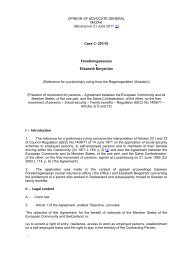Study on non-legislative initiatives for companies to promote gender ...
Study on non-legislative initiatives for companies to promote gender ...
Study on non-legislative initiatives for companies to promote gender ...
You also want an ePaper? Increase the reach of your titles
YUMPU automatically turns print PDFs into web optimized ePapers that Google loves.
Gender equality <strong>initiatives</strong> 133<br />
However, there are several challenges <strong>to</strong> overcome in order <strong>to</strong> fully utilise the<br />
advantages c<strong>on</strong>nected with engaging in a n<strong>on</strong>-<strong>legislative</strong> initiative:<br />
• Gender equality as a <strong>to</strong>p-down strategy: Gender equality assumes a climatic<br />
change in the enterprise’s culture. Regardless of which quality the implemented<br />
measures are, they require the unrestricted commitment of the management.<br />
Moreover, managers should act as role models <strong>to</strong> illustrate this organisati<strong>on</strong>al<br />
change.<br />
• Internal communicati<strong>on</strong>: The manager’s commitment and the measures have<br />
<strong>to</strong> be communicated accurately. Although <strong>gender</strong> equality is a <strong>to</strong>p-down<br />
strategy it takes shape in the interacti<strong>on</strong> of the whole staff. Thus, internal<br />
communicati<strong>on</strong> offering the possibility <strong>for</strong> an open discussi<strong>on</strong> between management<br />
and staff will be crucial. It will not be sufficient <strong>to</strong> just emphasise that<br />
<strong>gender</strong> equality has become <strong>on</strong>e of the company’s principles.<br />
• Costs: Measures <strong>for</strong> increasing <strong>gender</strong> equality entail costs. There are direct<br />
costs such as the investment <strong>for</strong> childcare services, the implementati<strong>on</strong> of<br />
teleworking stati<strong>on</strong>s, or training activities. But there are also indirect costs as<br />
e.g. a pers<strong>on</strong> will dedicate his/her working time <strong>for</strong> the co-ordinati<strong>on</strong> of <strong>gender</strong><br />
equality measures and the recruitment process could be l<strong>on</strong>ger if women are<br />
explicitly required in male-dominated sec<strong>to</strong>rs etc. The costs seem <strong>to</strong> be much<br />
more visible and occur immediately while, in c<strong>on</strong>trary, the benefits of <strong>gender</strong><br />
equality <strong>initiatives</strong> are more difficult <strong>to</strong> be assessed in terms of figures and<br />
normally are <strong>on</strong>ly visible in a l<strong>on</strong>g-term perspective.<br />
• Clear resp<strong>on</strong>sibility: The successful implementati<strong>on</strong> of measures often relies<br />
<strong>on</strong> the creati<strong>on</strong> of clear resp<strong>on</strong>sibilities. The best designed measures will fail if<br />
nobody is in charge of the implementati<strong>on</strong> and evaluati<strong>on</strong> and would assess<br />
whether targets are achieved or not. Such a pers<strong>on</strong> must have time <strong>to</strong> manage<br />
the process and the power <strong>to</strong> intervene if misguided developments occur or if<br />
the commitment lacks c<strong>on</strong>crete acti<strong>on</strong>s.<br />
4.4 Comparative assessment of n<strong>on</strong>-<strong>legislative</strong> <strong>initiatives</strong><br />
In the previous chapters important success fac<strong>to</strong>rs and challenges of n<strong>on</strong>-<strong>legislative</strong><br />
<strong>initiatives</strong> have been summarised and impacts in participating enterprises have been<br />
identified. Although these arguments are more or less true <strong>for</strong> all types of <strong>initiatives</strong>,<br />
there are still some differences in effectiveness and appropriateness.<br />
Looking closer at enterprise benefits resulting from the participati<strong>on</strong> in n<strong>on</strong>-<strong>legislative</strong><br />
<strong>initiatives</strong> it becomes obvious that prizes have broad marketing effects as awarding<br />
cerem<strong>on</strong>ies usually provoke a wide echo in the media. The same is true <strong>for</strong> rankings<br />
which, in additi<strong>on</strong>, are recognised as being very objective since based <strong>on</strong> quantitative<br />
data. In c<strong>on</strong>trast, labels and charters give enterprises the opportunity <strong>to</strong> clearly<br />
communicate their missi<strong>on</strong> statement respectively their commitment <strong>for</strong> <strong>gender</strong> equality<br />
and <strong>to</strong> present themselves proactively as a <strong>for</strong>ward-looking organisati<strong>on</strong>. The participati<strong>on</strong><br />
in a labelling process gives the enterprise the possibility <strong>to</strong> analyse and review its<br />
HR policy with the help of external c<strong>on</strong>sultants. Signing a charter often entails the<br />
possibility <strong>to</strong> enter a network of likeminded enterprises. In c<strong>on</strong>trast, compendia of good<br />
practices have positive side effects <strong>for</strong> other enterprises as they illustrate good<br />
practices <strong>on</strong> how <strong>to</strong> <strong>promote</strong> <strong>gender</strong> equality at the workplace.
















